Where you land in the affiliate marketing vs. influencer marketing debate will depend on your goals and desired outcomes. Both are powerful digital marketing strategies—but failing to grasp their unique strengths, how best to combine them or how each delivers real ROI can lead to missed opportunities and wasted budget.
To turn your uncertainty into a clear path forward, you’ll need to understand how both digital marketing tactics work, when to deploy them and why combining both often maximizes results.
The right tools make managing either strategy—or both—surprisingly straightforward.
What is affiliate marketing?
Affiliate marketing is a performance-based marketing strategy where businesses pay commissions to external partners (affiliates) for driving sales, lead generation or other desired conversions through their promotional efforts. Essentially, it operates on a “pay-for-performance” model: Affiliates only earn money when they successfully produce measurable outcomes.
Though it was once predominantly associated with traditional tactics like listings on coupon sites, price comparison websites, product review blogs and cashback platforms, this type of marketing has transformed with the rise of influencer marketing.
By way of example, this Wired2Fish.com article on fishing rods is a classic example of blogger-driven affiliate marketing:

Source: wired2fish.com
Clicking the “Buy at Tackle Warehouse” button for the Shimano Poison Adrena B Series fishing rod will send readers to a retail site via this affiliate link:
https://www.tacklewarehouse.com/Shimano_Poison_Adrena_BFS_Casting_Rods/descpage-PABFS.html?**from=w2fish
The from=w2fish tag in the URL tells the retailer where the customer came from so wired2fish.com receives its commission.
Today, social media has blurred the lines between affiliate marketing and influencer marketing. Take this Instagram post from Making Frugal Fun, for example:

Source: Instagram
The influencer shares their genuine experience with Our Place cookware and directs followers to purchase it through an affiliate link. The URL includes a unique identifier tag (tag=cairnsfamilycreativ-1-ltkna-20) to track a customer’s origin and ensure the influencer’s commission.
The cost of affiliate marketing
Depending on the industry, businesses typically pay between 5% and 50% in commissions (digital products and software generally offer higher affiliate commission rates than physical goods). Companies can structure affiliate payments using flat fees, percentages or tiered systems to reward top performers.
Tracking platforms like Impact, ShareASale and Commission Junction automatically process most affiliate payments. They monitor link clicks, conversions and sales, then distribute payments to affiliates, either monthly or once earnings hit a payout minimum.
Essential affiliate marketing metrics to track
To maximize profitability in affiliate marketing, where you pay a commission on every sale, your measurement strategy needs to extend beyond just top-line ROI.
While ROI is the ultimate indicator of campaign health and profitability, the following essential metrics are valuable diagnostics that help you spot opportunities for optimization and multiply returns:
- Revenue and margin per affiliate: Shows you which partners to keep, coach or drop
- Click-through rates: Reveals if affiliates are driving relevant traffic to your offers
- Conversion rates by affiliate: Pinpoints where traffic quality breaks down in your funnel
- Average order value: Indicates whether affiliates attract high-value customers
This approach helps you decide whether to recruit different affiliates, adjust commission structures or coach existing partners on better promotion strategies. For example, if an affiliate generates high traffic but low conversions, the issue might be a mismatch in the target audience rather than commission rates.
What is influencer marketing?
Influencer marketing involves brands partnering with content creators to promote their products on social media accounts. Businesses typically pay creators up-front fees for content creation that focuses on brand visibility and trust-building rather than direct sales conversions.
There are four main influencer tiers:
- Nano influencers: Less than 10K followers
- Micro-influencers: Between 10K and 100K followers
- Macro-influencers: Between 100K and 1M followers
- Mega influencers: Over 1M followers
While macro-influencers can boast larger follower counts, their follower base may have passive followers mixed in with their deeply engaged followers. So don’t discount nano and micro-influencers because of their smaller follower counts—what they lack in numbers, they often make up for with loyal, hyper-engaged audiences. It’s this stronger engagement that often makes smaller influencers surprisingly powerful for driving action.
A compelling example of this is micro-influencer Ashleigh Monet’s review of the LokLik cutting machine on YouTube. She builds trust with her audience by showcasing the product’s strengths and weaknesses and providing genuine product experience and tutorial content. By including an affiliate link in her description, she blends influencer authenticity with affiliate performance tracking.
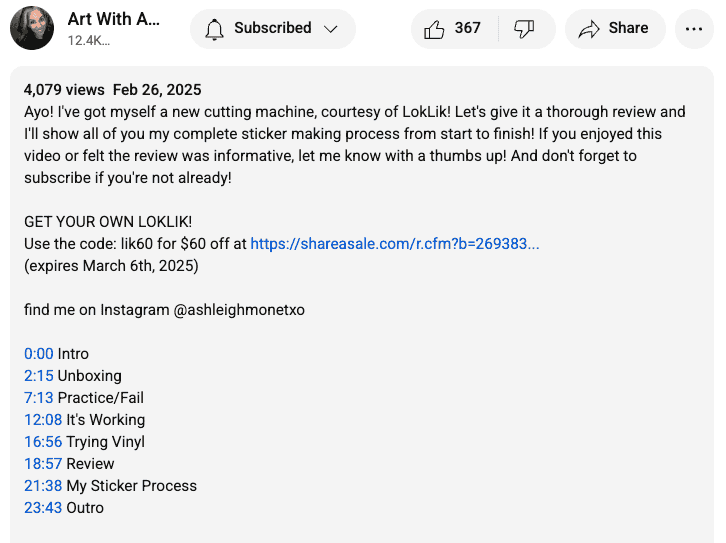
Source: YouTube
The key distinction is that influencer marketing pays for the reach and brand association that can lead to sales, while affiliate marketing pays for direct sales and conversions. Most successful creators now operate as affiliate marketing influencers, adapting their approach based on brand partnerships and campaign goals.
The cost of influencer marketing
Influencer marketing remains cost-effective, even as more creators enter the space. According to Sprout Social’s 2025 Influencer Marketing Report, nearly half of influencers charge anywhere from $250 to $1,000 per post—but 71% offer discounts for long-term partnerships that involve multiple posts, which makes ongoing collaborations more budget-friendly for brands. An additional 25% are open to considering discounts in the future too, which suggests that cost flexibility is widespread.
These dynamics give brands room to stretch marketing budgets while still compensating creators fairly, especially when the product is premium or the partnership has strong creative alignment.
Essential influencer marketing metrics to track
As with affiliate marketing, effectively measuring influence marketing ROI starts with tracking revenue impact. Although the specific metrics may differ, your measurement strategy should remain the same: Monitor the impact of your spend on revenue, then work backwards, choosing metrics that will help you optimize and prove ROI.
These metrics include:
- ROI and ROAS: Evaluates the profitability of your creator investments
- Conversion attribution: Shows actual sales that each creator using affiliate links
- Earned media value: Estimates the advertising value equivalent of organic reach
- Engagement rate vs. conversion rate: Shows if high engagement translates to purchases
- Cost per acquisition (CPA) by creator tier: Compares nano, micro-, macro- and mega influencers
Analyzing these metrics helps you decide whether to reallocate spending toward different creator tiers, negotiate performance-based contracts or completely revamp your content strategy. For example, if micro-influencers show a better CPA than macro-influencers, you might redirect your budget to work with more niche creators.
Affiliate marketing vs. influencer marketing: 6 key differences
The fundamental difference comes down to this: An affiliate marketing strategy is transactional, but influencer marketing is relational. One pays for outcomes, and the other pays for trust. That distinction shapes everything else about how you’ll manage these strategies, such as the following:
| Affiliate marketing | Influencer marketing | |
| Primary objective | Drive immediate sales and conversions | Build brand awareness and credibility |
| Payment structure | Commission-based (pay only for results) | Up-front fees, plus potential bonuses |
| Risk level | Low financial risk (pay per conversion) | Higher up-front investment risk |
| Creative control | Limited (affiliates choose promotion methods) | High (brands collaborate on content strategy) |
| Content authenticity | Varies widely by affiliate type | Typically more authentic and personal |
| Performance measurement | Direct attribution through tracking links | Complex attribution across awareness and sales |
You don’t have to choose between affiliate marketing and influencer marketing—many brands use both. But keep in mind that your choice will come down to your priorities and industry. Do you want to invest in brand trust up front or pay only for confirmed sales and conversions?
When to choose influencer marketing or affiliate marketing
The choice between influencer marketing and affiliate marketing comes down to your goals and measurement needs. Begin by nailing down your primary objective: building awareness or driving sales. Then consider your budget constraints and content requirements.
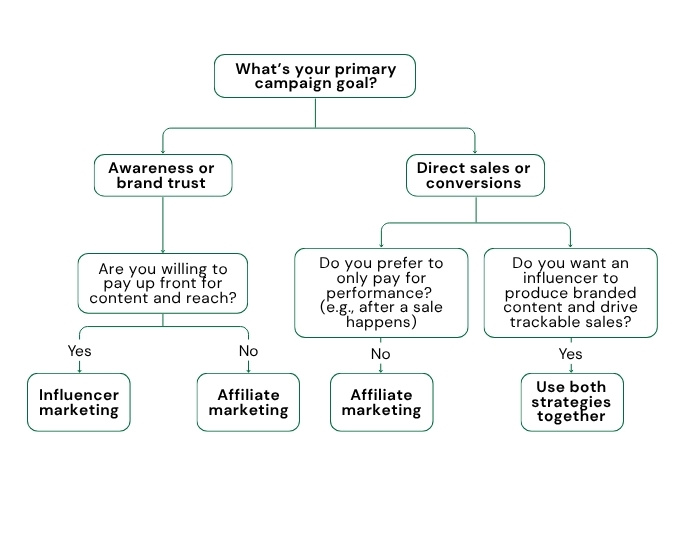
Also, you should look into your partners’ audience demographics, competitor strategies and how to best position your brand. Answering these core questions will guide your campaigns in the right direction.
When to use affiliate marketing
Affiliate marketing works well when you have a conversion problem. If people are aware that your product exists but you need more efficient ways to reach buyers, for instance, this can be a valuable strategy.
A great example of this is Notion’s affiliate marketing program, which offers $50 per signup, plus 20% of first-year revenue. The company knows that its trial-to-paid conversion rates and customer lifetime value support those payouts.

Source: Notion
Like influencer marketing, affiliate marketing thrives when promotions feel like natural content, not advertising. If you choose this route, avoid the trap of blasting links everywhere and hoping for quick clicks. Sustainable affiliate programs work more like referral networks—you have to collaborate with partners whose audiences genuinely trust their recommendations.
When to use influencer marketing
Influencer marketing makes sense when brand exposure is your bottleneck. Use it when people need to see your product in action in someone else’s life before they consider trying it. After all, when you hire the right influencer, their content will feel like a friend’s recommendation, not a commercial.
Sanrio deliberately built the marketing strategy for its Hello Kitty Cafe Truck this way. Instead of paying for product placement, it creates experiences that are worth sharing on feeds. The Cafe Truck tours the US, sparking excitement and community moments. This generates content that feels authentic—because it is.
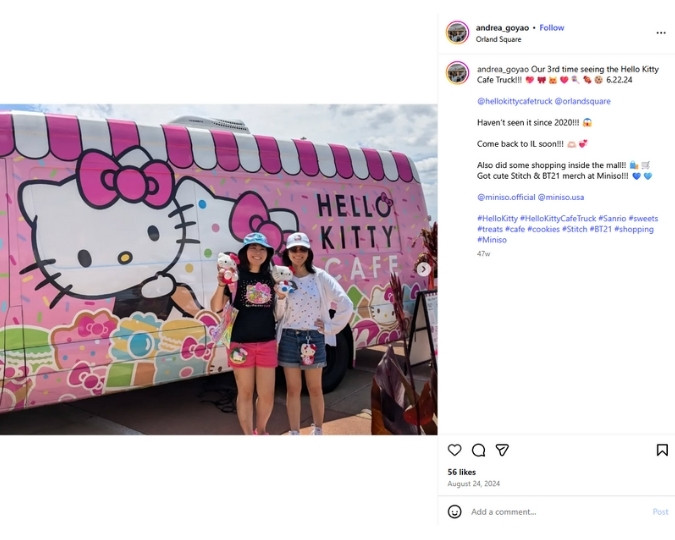
Source: Instagram
The biggest challenge with influencer marketing is accurately measuring its effectiveness. With it, you’re investing in brand equity that grows slowly and reaches customers who might not convert right away. If you need immediate, trackable ROI, affiliate marketing is your answer. But if you’re building long-term brand value and your leads database, influencer marketing can be much more powerful.
Integrating affiliate and influencer marketing strategies
Many creators are both affiliates and social media influencers. Treating them as complementary—instead of separate—can make your combined influencer and affiliate marketing efforts more coherent, measurable and effective.
Here’s how to achieve this synergy:
Pair content creators with goals
Matching the right influencer to the right objective is one of the most critical—and often overlooked—aspects of this process. While follower counts grab plenty of attention, content format and audience intent are usually more valuable. For example, a creator with a 20K following who users know for their in-depth tutorials or honest product reviews can drive strong affiliate revenue due to their highly engaged audience. Meanwhile, a lifestyle creator with 1M followers might be your ideal partner for top-of-funnel storytelling and brand awareness.
Before picking your creators, take a close look at their content format and consider how often they post shoppable content and what their audience is primed to do. If a creator regularly posts “my favorite things” roundups, for instance, they’re likely to outperform in performance campaigns, regardless of their size.
Use influencer marketing and affiliate tools together
There’s usually a difference between where you track affiliate links and where you manage influencer relationships. Most affiliate platforms generate unique links, handle tracking and manage payouts.
However, influencer marketing tools, like Sprout Social’s Influencer Marketing solution, give you the tools you need to discover creators, manage outreach and approvals, and monitor content performance. The tool seamlessly integrates with your affiliate tracking, which enables you to assign UTM parameters or custom links to each creator. That way, you can track their social media engagement and traffic for affiliate performance insights.
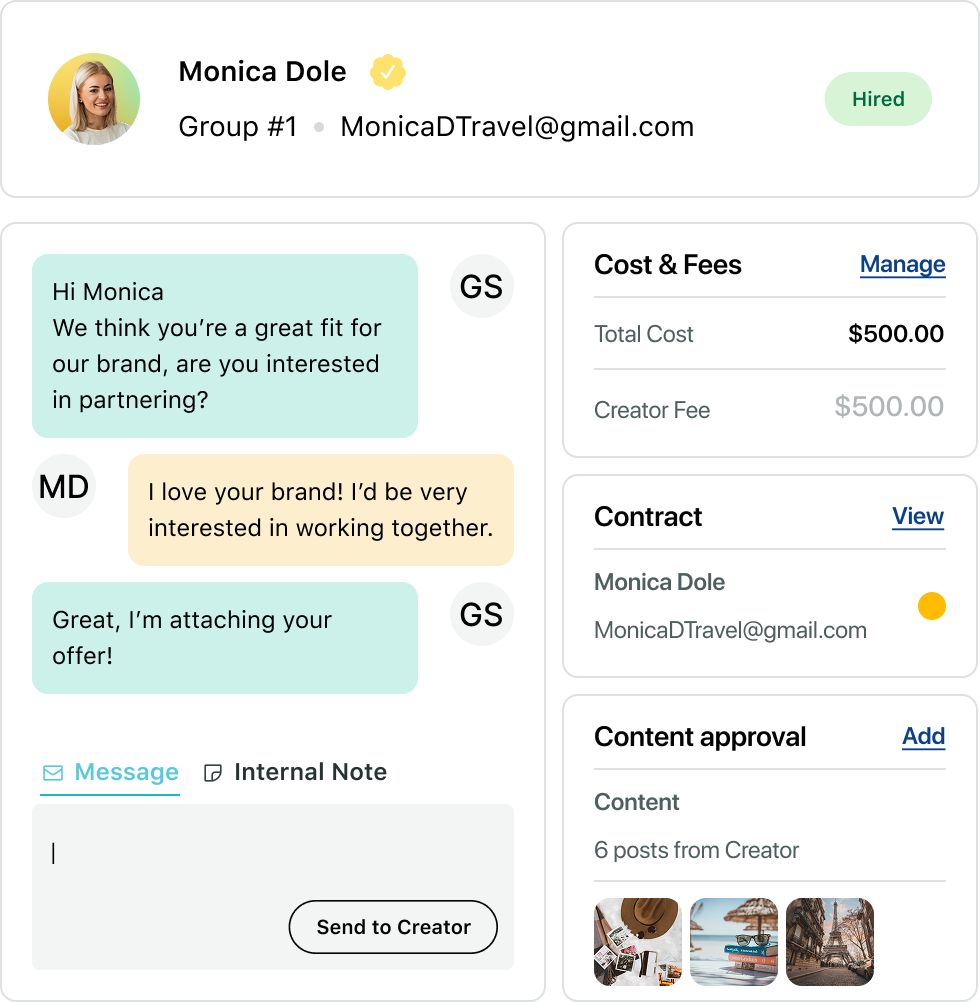
Sprout helps you manage influencer relationships and measure content performance, while your affiliate platform handles the technical tracking and payments. Though these two systems are separate, you can easily coordinate them.
Track results across both strategies
If you want to understand ROI, you can’t look at influencer and affiliate marketing efforts in isolation—these strategies often influence the same buyers. For example, a TikTok video might introduce someone to your brand, but an affiliate blog post may close the deal days later.
Sprout’s platform provides visibility into the key metrics for both strategies. You can then track link clicks, engagement rates and creator performance over time.
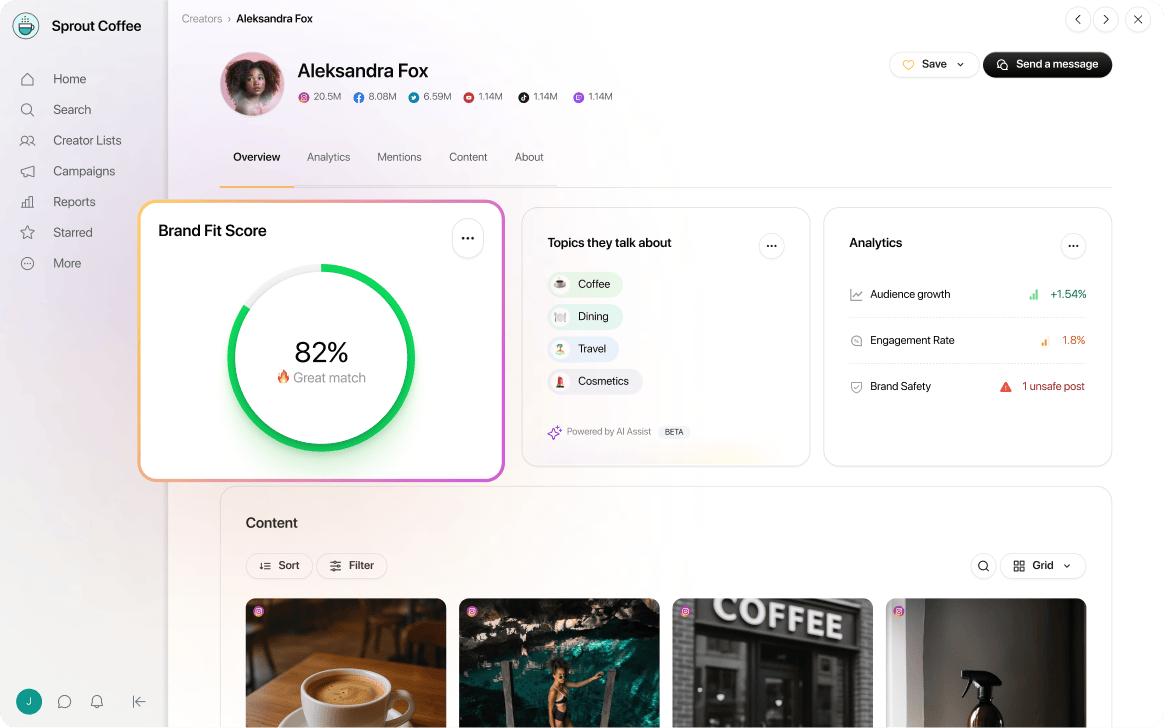
For revenue attribution, you’ll typically integrate with platforms like Tableau, Looker or your CRM. Sprout supports that process by surfacing campaign performance insights, such as which content is working and which creators are driving traffic, while integrations with tools like Tableau connect those insights to revenue impact.
Customize landing pages for creator traffic
Sending all creator traffic to a generic homepage is a missed opportunity. You don’t need a custom landing page for every individual influencer, but you should group creators by content type or audience and send traffic to pages that feel relevant.
For example, if three creators are promoting your back-to-school collection, give them a co-branded landing page that reflects that theme—using copy or imagery that matches their messaging will make the transition from social feed to landing page feel seamless. You can also include the creator’s name, discount code or curated picks to increase trust and reduce bounce.
Choosing between affiliate marketing and influencer marketing
The choice between affiliate marketing and influencer marketing doesn’t have to be an either/or dilemma. The most successful brands skillfully use both strategies in tandem: influencers for authentic product introductions and affiliates for optimized conversion paths.
With Sprout Social Influencer Marketing, managing both approaches becomes significantly easier. You can use it to discover creators, track performance metrics and measure ROI across affiliate and influencer campaigns from a centralized dashboard.
Check out the free demo today to see how Influencer Marketing by Sprout Social (formerly Tagger) can help you evaluate and manage your affiliate and influencer strategies—all in one place.